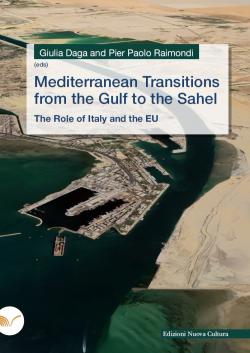Mediterranean Transitions from the Gulf to the Sahel. The Role of Italy and the EU
The war on Gaza, the war on Ukraine, the energy crisis, and several initiatives to reshape regional and international partnerships and alliances have made the EU Southern Neighbourhood even more strategic for Italian and European interests. The urgency to diversify the energy supply (drawing on both fossil fuels and clean energy sources) has pushed Italy to strengthen old and create new partnerships with countries on the southern shore of the Mediterranean, as well as turn to countries in sub-Saharan Africa. This is aimed at both transforming Italy into an energy hub and becoming autonomous from Russia. A reflection on energy supply diversification and political reconfigurations necessarily considers the highly strategic Red Sea and Gulf regions, which are increasingly interconnected with the EU’s Southern Neighbourhood in both political and economic terms, as acknowledged by the recent European energy strategy. The volume focuses on the most recent energy and political realignments involving actors in the areas, with an eye to identifying guidelines for an integrated approach able to respond to the priorities of Italian and European foreign policies.
Volume produced in the framework of the project “Mediterranean transitions: risks and opportunities for the Italian and European foreign, energy and security policies in the Southern Neighbourhood”.
-
Details
Rome, Nuova Cultura, September 2024, 139 p. -
Issue
11 -
ISBN/ISSN/DOI:
978-88-3365-701-1 ; 10.4458/7011
Contributors, p. 7-8
List of abbreviations, p. 9-10
Introduction, by Giulia Daga and Pier Paolo Raimondi, p. 11-14
1. EU-African Energy and Climate Cooperation in Light of Reconfiguration of Energy Flows, by Pier Paolo Raimondi, p. 15-36
1.1 Current EU-Africa energy trade and perspectives for higher contribution
1.2 Potential future contribution – critical raw materials and hydrogen
1.3 Domestic energy needs
1.4 Different challenges to EU-Africa cooperation
1.5 The Italian Mattei Plan: A positive initial step
2. Regional Energy Cooperation in the Gulf: What Role for Europe?, by Mehran Haghirian, p. 37-57
2.1 European energy interests in the Gulf
2.2 Oil
2.3 Gas
2.5 Power generation and electricity
2.6 Solar and wind
2.7 Water
2.8 Minerals
2.9 Nuclear energy
2.10 Conclusion
3. Regional Reconfigurations and Geopolitical Shifts in the Sahel and Mediterranean, by Darlington Tshuma, p. 59-80
3.1 Impact of fragility on security, governance and democracy in the Sahel
3.2 The Sahel’s triple challenge: Integrating humanitarian, development and security agendas
3.3 Dynamics of fragility and insecurity in the Sahel
3.4 Geopolitical competition and posturing in the Sahel
3.5 Regime reconfiguration and geopolitical pivoting and its impact on security in the Sahel
3.6 Russia’s military-economic footprint in the Sahel: Implications for European policy
3.7 Opportunities and challenges for Italian foreign policy in the Sahel and Mediterranean regions
3.8 Conclusion
4. Constructive Diplomatic Shifts in the Geopolitical Landscape of the Gulf, by Mehran Haghirian, p. 81-102
4.1 Era of maximum regional tensions in the Gulf
4.2 Restoring diplomatic ties in the Gulf
4.3 Challenges facing the durability of diplomatic engagements in the Gulf
4.4 Europe’s role in supporting regional diplomacy in the Gulf
5. Global Powers and the Wars of Narratives: China, Russia and the US Navigating Transitions in the Middle East and Africa, by Giulia Daga, p. 103-132
5.1 The People’s Republic of China
5.2 The Russian Federation
5.3 The United States of America
5.4 Implications for Europe
6. Conclusions: Italy in a Shifting Global Order, by Maria Luisa Fantappiè, p. 133-139



